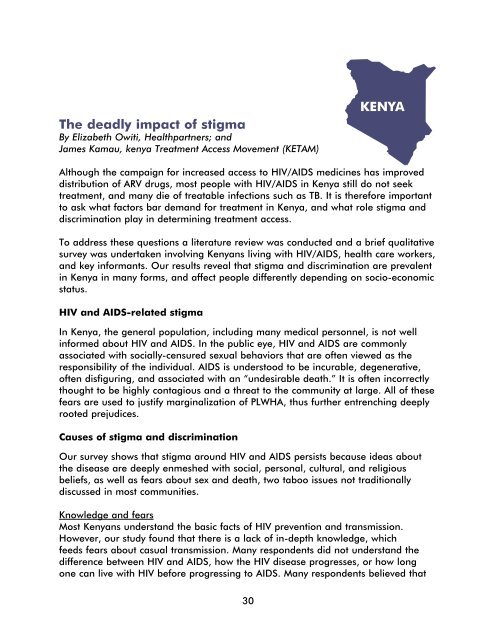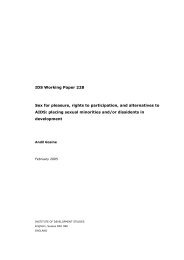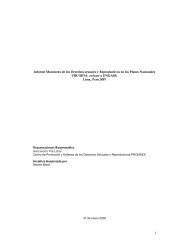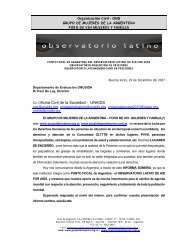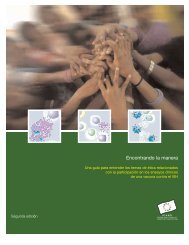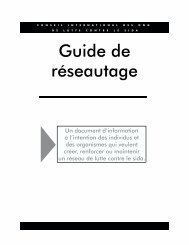RUSSIAMigrantsRussia, with <strong>the</strong> second largest immigrant population in <strong>the</strong> world, has a growingnumber of labor migrants who face heightened vulnerability to HIV and hinderedaccess to care. Migrants, especially those without documentation, face difficultiesaccessing medical care as most HIV care facilities provide care only to those withan official residence permit. Nei<strong>the</strong>r prevention nor treatment services are adaptedto <strong>the</strong> language and cultural needs of migrants. The threat of deportation serves todeter migrants from accessing medical services. According to Russian law, foreigncitizens living with infectious diseases must be deported to <strong>the</strong>ir home countries;however this does not always occur. In 2007, 1,189 foreign people and non-citizenscrossing <strong>the</strong> border were identified as HIV-positive, according to data from <strong>the</strong>Russian Federation Federal Service for Surveillance on Consumer Rights Protectionand Human Welfare, and 223 were deported.PrisonersRussia has one of <strong>the</strong> world’s highest rates of incarceration, with <strong>the</strong> majority ofpeople in <strong>the</strong> prison system serving time on charges related to illegal drugs. Of808,000 prisoners in <strong>the</strong> system in September of 2005, 37,000 were living withHIV, so nearly 5% of <strong>the</strong> prison population is HIV-positive. 1 Studies have shownthat drug use continues in prison and that people are actually more likely toshare injection equipment in prison than outside due to <strong>the</strong> difficulty of acquiringsyringes. Risk-taking sexual behavior and sexual violence inside prisons are alsoreported. Though some health promotion programs exist in prisons, syringes are notdistributed and condoms very rarely.RecommendationsScale up existing model programs for linking testing, prevention,treatment care, and support services and integrate <strong>the</strong>se services with TB,hepatitis, addiction and o<strong>the</strong>r services.The scope, coverage, and quality of evidence-based and user-friendlyprevention programs targeting vulnerable populations should beimproved, as should <strong>the</strong> incorporation of case-finding initiatives within<strong>the</strong>m to improve treatment uptake.Improve access to non-discriminatory voluntary testing and counselingservices with special attention to protection of confidentiality and privacy.Social support, including peer counseling and case management, shouldbe designed to increase treatment uptake by vulnerable groups.Prevention and treatment programs should address <strong>the</strong> social exclusionthat often leads to marginalization and vulnerability.National funds for prevention should be increased substantially, focusingon evidence-based policies and approaches that are integrated withtreatment programs.1 Transatlantic Partners Against <strong>AIDS</strong> (TPAA). Right to Health: Prevention and Treatment of HIVinfectionamong Most At-Risk Populations. Informational Bulletin No 3(5). December 2006.29
The deadly impact of stigmaBy Elizabeth Owiti, Healthpartners; andJames Kamau, kenya Treatment <strong>Access</strong> Movement (KETAM)Although <strong>the</strong> campaign for increased access to HIV/<strong>AIDS</strong> medicines has improveddistribution of ARV drugs, most people with HIV/<strong>AIDS</strong> in Kenya still do not seektreatment, and many die of treatable infections such as TB. It is <strong>the</strong>refore importantto ask what factors bar demand for treatment in Kenya, and what role stigma anddiscrimination play in determining treatment access.To address <strong>the</strong>se questions a literature review was conducted and a brief qualitativesurvey was undertaken involving Kenyans living with HIV/<strong>AIDS</strong>, health care workers,and key informants. Our results reveal that stigma and discrimination are prevalentin Kenya in many forms, and affect people differently depending on socio-economicstatus.HIV and <strong>AIDS</strong>-related stigmaIn Kenya, <strong>the</strong> general population, including many medical personnel, is not wellinformed about HIV and <strong>AIDS</strong>. In <strong>the</strong> public eye, HIV and <strong>AIDS</strong> are commonlyassociated with socially-censured sexual behaviors that are often viewed as <strong>the</strong>responsibility of <strong>the</strong> individual. <strong>AIDS</strong> is understood to be incurable, degenerative,often disfiguring, and associated with an “undesirable death.” It is often incorrectlythought to be highly contagious and a threat to <strong>the</strong> community at large. All of <strong>the</strong>sefears are used to justify marginalization of PLWHA, thus fur<strong>the</strong>r entrenching deeplyrooted prejudices.Causes of stigma and discriminationOur survey shows that stigma around HIV and <strong>AIDS</strong> persists because ideas about<strong>the</strong> disease are deeply enmeshed with social, personal, cultural, and religiousbeliefs, as well as fears about sex and death, two taboo issues not traditionallydiscussed in most communities.Knowledge and fearsMost Kenyans understand <strong>the</strong> basic facts of HIV prevention and transmission.However, our study found that <strong>the</strong>re is a lack of in-depth knowledge, whichfeeds fears about casual transmission. Many respondents did not understand <strong>the</strong>difference between HIV and <strong>AIDS</strong>, how <strong>the</strong> HIV disease progresses, or how longone can live with HIV before progressing to <strong>AIDS</strong>. Many respondents believed that30
- Page 1 and 2: Missing the Target #5:Improving AID
- Page 4 and 5: ArgentinaDr. María Lorena Di Giano
- Page 8 and 9: Executive SummaryAt the G8 meeting
- Page 12: • UN agencies should provide incr
- Page 16 and 17: Price should not be a barrier when
- Page 18 and 19: The Global Fund and UNITAID: The Fu
- Page 20 and 21: The real cost of free treatmentBy a
- Page 22 and 23: Remaining work for asuccessful prog
- Page 24 and 25: DOMINICAN REPUBLICto access rapid t
- Page 26 and 27: DOMINICAN REPUBLICIn Santo Domingo
- Page 28 and 29: ZIMBABWEtreatment, representing 35
- Page 30 and 31: ZIMBABWEAccording to the Medicines
- Page 32 and 33: ZIMBABWEZimbabwe’s application fo
- Page 34 and 35: ZIMBABWENational government• Addr
- Page 38 and 39: a person with HIV will die very qui
- Page 40 and 41: FamiliesIn Kenya, families are the
- Page 42 and 43: INDIA2. Provide pediatric formulati
- Page 44 and 45: Linking nutrition and treatmentBy W
- Page 46 and 47: Most people living with advanced HI
- Page 48 and 49: only available in the capital, Yaou
- Page 50 and 51: ZAMBIAFindings in particular provin
- Page 52 and 53: The DACA for Chadiza District was a
- Page 54 and 55: Many health care workers are inadeq
- Page 56 and 57: DRUG REGISTRATION BARRIERS & LOGJAM
- Page 58 and 59: Country ATV RLPV/rLPV/r(HS)TDFArgen
- Page 60 and 61: development and registration. Likew
- Page 62 and 63: Capacity issues and delays in the W
- Page 64 and 65: Lack of post-approval quality assur
- Page 66 and 67: ARV PROCUREMENT, REGISTRATION,AND S
- Page 68 and 69: ARGENTINAParallel importingRelating
- Page 70 and 71: ARGENTINAAccess to ARVsNo difficult
- Page 72 and 73: Viral load tests are available, but
- Page 74 and 75: Cambodiaby Mony PenOnly pharmacists
- Page 76 and 77: ChinaBy anonymous Missing the Targe
- Page 78 and 79: CHINAThe current process for regist
- Page 80 and 81: Dominican RepublicBy Eugene Schiff
- Page 82 and 83: IndiaBy Abraham KK, Celina D’Cost
- Page 84 and 85: MalawiBy Lot Nyirenda and Grace Bon
- Page 86 and 87:
MALAWIStock-outsAccording to an ext
- Page 88 and 89:
MoroccoBy Othman MelloukMorocco has
- Page 90 and 91:
Determine the patent status of all
- Page 92 and 93:
MOROCCOThe shortage occurred becaus
- Page 94 and 95:
As of November 2007, the unit cost
- Page 96 and 97:
NIGERIADiagnostic testsDiagnostic t
- Page 98 and 99:
The government’s initial inabilit
- Page 100 and 101:
Increase training and capacity buil
- Page 102 and 103:
treatment practice. The Minster ann
- Page 104 and 105:
Ugandaby Richard Hasunira, Prima Ka
- Page 106 and 107:
UGANDAExtracts from the MoH’s rep
- Page 108 and 109:
ZAMBIAIn gathering this information
- Page 110 and 111:
However, since manufacturing prices
- Page 112 and 113:
105SHORT SUMMARY
- Page 114:
PAKISTANAccess for marginalized gro


